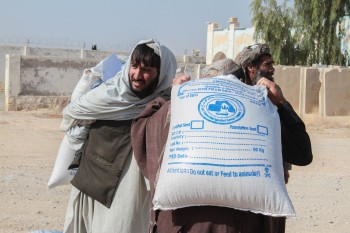
Project Name: Integrated Nutrition, Mortality, IYCF, FSL and WASH SMART Survey
Target Area: Nangarahar Province
Target Population: Children under five and CBA women Overall Objective:
Implemented by: Afghanistan Research Development and Health Organization
Technical Support Provided by: Action Against Hunger
Collaborators: PND, DoPH, Nutrition Cluster and MoPH
Donor: ECHO
Overall Objective:
The overall objective of the survey is to assess the nutritional status among the vulnerable population (under-five children & PLWs), crude and under-five retrospective death rates in Nangarahar province.
Specific Objective:
v To estimate the prevalence of undernutrition (Stunting, Wasting, Underweight) among children under 5 years of age.
v To estimate the Crude Death Rate (CDR) and under-five Death Rate (U5DR).
v To determine core Infant and Young Child Feeding (IYCF) practices among children aged <24 months.
v To estimate second dose measles vaccination coverage among children 18-59 months.
v To determine the nutritional status of pregnant and lactating women (PLW) and women of reproductive age (15-49 years) based on MUAC assessment.
v To assess Water, Sanitation, and Hygiene (WASH) proxy indicators: households level main drinking water sources and caregiver handwashing practices.
v To assess the food security situation through the Food Consumption Score (FCS) and the Reduced Coping Strategies Index (rCSI).
Result:
The results of this survey are not a reflection of the national nutrition situation but they are the only representative of the population living in all Twenty-Two districts of the Nangarhar province. The results of this survey showed a GAM and SAM prevalence of 9.6% (7.5-12.2 95% CI) and a 1.8% (1.0- 3.3 95% CI) respectively; based on MUAC, the prevalence is at 10.1% (7.9-12.9 95% CI) and 2.4% (1.5- 3.9 95% CI) GAM and SAM respectively. The prevalence falls under the medium category of emergency-threshold classification as per the latest update WHO/UNICEF 2018 threshold. However, considering the upper limit of the WHZ CI (12.2%), it’s in the high category of public health significance. The SAM rate by WHZ is however below the 3.0% threshold established by the MOPH, Nutrition Cluster, and the AIM-WG for the response prioritization in the Afghanistan context as contrary to the international emergency threshold of SAM above 2.0%. The WHZ GAM rate observed in the current survey indicates a decline in the prevalence of acute malnutrition over the last three years. . The expectation was also an improvement in the malnutrition situation over the past three years due to expanded nutritional services into new Heath Facilities, and Mobile Teams, and newly established OPD SAM, OPD MAM sites, and hired more than 60 Nutrition consular in the province. Currently, there are 89 OPD-SAM, 6 IPD-SAM, and 52 OPD MAM.
Estimation of the prevalence of malnutrition based on Combined GAM continues to add impetus to the importance of the independence diagnosis criteria of GAM by WHZ and MUAC in the identification of malnutrition hence ensuring greater coverage of children in need of treatment as demonstrated by the 15.7% (13.1-18.8 95% CI) combined GAM rate as opposed to 9.6% (7.5 –12.2) based on WHZ alone. This translates to a significant difference of caseload of acutely malnourished children.
Chronic malnutrition in Nangarhar province remains of public health concern. The prevalence of chronic malnutrition among children 6-59 months was 33.7% (29.6-38.0 95% CI), which is classified as very high according to the UNICEF-WHO 2018 thresholds. In other words, about 1 in 3 children in Nangarhar province are not reaching optimal growth and development. Statistically, significant deterioration was observed in the chronic malnutrition; the prevalence of total stunting increased to 39.5% (34.6-44.7 95% CI) in December 2016 compared to 33.7% (29.6-38.0 95% CI) in March 2020.
The high prevalence is compounded further by the simultaneous presence of acute malnutrition resulting in a double burden of malnutrition. Recent research has concluded that children who are both stunted and wasted are at a heightened risk of mortality16, further suggesting that this should be a priority group for treatment interventions. In Nangarhar province, it was found that among the 237 stunted children, 47 of them (19.6%) were also wasted by both criteria (WHZ<-2SD + MUAC<125 mm) and 11 of them (4.6%) were severely wasted.
Acute malnutrition among women in Nangarhar province is always of concern, although there is no globally defined cut-off for acute malnutrition among women by MUAC. The results indicated 10.6% of pregnant and lactating women (PLW) were suffering from acute malnutrition. However, this shows increment compared to 8.5% in 2016; however, the increment is not statistically significant at P-Value is 0.5992.
Comparing the current SMART finding with the previous one suggests highlighted improvement in the IYCF indicators, indicating effective implementation of the nutrition and health program over the last couple of years. IYCF practices in Nangarhar province based on the findings of the current SMART survey shows improvement compared to the result of 2016 SMART survey. This survey estimates that only 62.5% of the children were exclusively breastfed before six months of age; a good excess in the exclusive breast-feeding rate compared to 2016 SMART (36.5%). The proportion of children breastfed within 1 hour after birth was 88.2 %.
Immunization is an important public health intervention that protects children from illness and disability. Based on this survey, 97.5% of children age 9-59 months, and 92.3% of the surveyed children between 18 to 59 months were immunized against measles. This shows relatively satisfactory coverage, but still high than the national target of 90.0%, thanks to a well-functioning Expanded Program on Immunization “EPI” at the national and provincial levels. Figure 20 illustrates the changes in measles second dose vaccination over the past three years.
The CDR and U5DR were below the WHO emergency threshold, with CDR of 0.46 death/10,000/Day and U5DR 0.52 death/10,000/Day.
Implemented by: Afghanistan Research Development and Health Organization
Technical Support Provided by: Action Against Hunger
Collaborators: PND, DoPH, Nutrition Cluster and MoPH
Donor: ECHO
Photo Gallery








